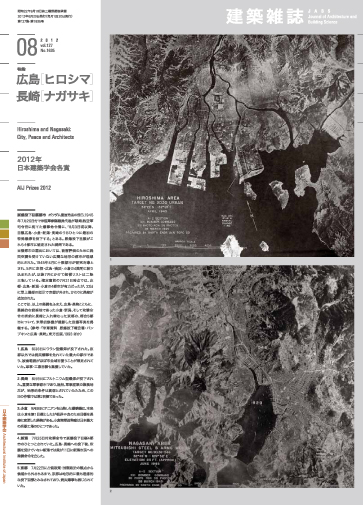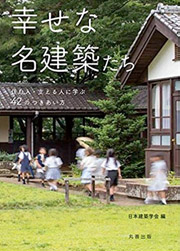本文PDFの閲覧につきましては、こちらでご確認ください。

2012-8月号 AUGUST
特集= 広島[ヒロシマ]・
長崎[ナガサキ]
Hiroshima and Nagasaki: City, Peace and Architect
特集前言 被爆都市は複数だった:広島・長崎が問う都市・平和・建築家
1945年8月、広島と長崎に原爆が投下され、敗戦を迎えた日本は「平和」を掲げて再出発する。二つの「被爆都市」は以来、都市の世界史のなかで特別な意義を背負った。
しかし、広島と長崎が被爆都市となった背景には、本号の表紙に示すように、投下目標候補とされた一群の都市があり、原爆の模擬的投下が実施された数十の都市がある。これらと焼夷弾の空襲を受けた無数の都市とは表裏の関係にあり、そして、忘れがちであるが日本が統治あるいは占領したアジアの数多の都市もまた破壊と再建を余儀なくされた。
都市の持続こそが「平和」の徴であり証であるとすれば、広島・長崎の経験は、これらすべての都市が描いてきた幾筋もの重なり交わる軌跡のなかで、特異であると同時に普遍的でもある「問い」として捉え返されるべきだろう。
両都市の名前はいつしかカタカナの「ヒロシマ」「ナガサキ」として流布し、今「フクシマ」がそうであるように、ローカル/グローバルな政治的思惑のなかで特殊な意味を放つ符牒のごときものになった。しかし、これらいずれもが政治的符牒である以前に厚い歴史的蓄積を持った固有の土地の名であり生活の場であったことを思い出したい。
本号では、『建築雑誌』として初めて広島と長崎を特集する。これまでもっぱら注目を集めてきた戦争・被爆・平和の「メモリアル」たる記念建築物よりもむしろ、被爆という事件から生活の安寧が再獲得されてきた場として両都市を読み直す。もちろん、生活の再建と、被爆経験に絡み付く政治性とが不可分であったことは、両都市の特殊な事情として留意が必要である。
広島と長崎をできるだけ同等のヴォリュームで扱うことを、本号の編集ポリシーとした。取材を始めると、二つの被爆都市のあいだには、原爆投下という「出来事」の受容にも、「平和」の理解にも、それらを都市・生活の再建と結び合わせる回路にも、予想以上に大きな隔たりがあることに気づかされた。その背景に、少なくとも近世に遡る両都市の社会構造・統治構造の歴史的差異があることも無視できない。一つひとつの言葉がこうした前提の上に受け止められるべきだろう。
第1部は、建築家や建築専門家が、被爆後の広島と長崎にどう向き合ってきたのかの証言である。終戦直後に丹下健三の下で広島の復興計画に取り組んだ大谷幸夫氏。長崎の復興期に武基雄研究室に在籍した髙津昭生・竹山実・渡辺満の諸氏。広島の"原爆スラム"の生活を記録した千葉桂司・矢野正和の両氏と、同地に立ち上がった基町・長寿園高層アパート(大高正人設計)に携わった藤本昌也氏。そして都市史研究者として広島と長崎の戦後をアーカイブ化する地道な活動を継続している石丸紀興氏。
第2部では、まず杉本俊多氏と林一馬氏に、広島・長崎という二つの都市が辿ってきた固有の歴史を見透していただいた後に、二編のインタビューを置いた。元長崎市長の本島等氏は、長崎固有の被爆経験にまつわる、「都市」の一語には収まらない社会的諸関係の複雑さ・多様さを消さずに認めていく原理としてのカトリックについて、重みと軽妙さを兼ね備えた独自の語り口で説いてくださった。広島駅前のヤミ市で育ち、市職員として戦後の都市建設の現場を生き抜いてきた加藤英海氏は、自身を一個の「都市」に固く結び付けられた個人としてとらえ、自らの決断の連続を回顧された。
第3部では、建物の衝撃・崩壊問題を専門とする磯部大吾郎氏に『原子爆弾災害調査報告書』を読んでいただき、石田雅春氏には広島における「被爆建造物」の保存運動とその厳しい現況を報告していただいた。映画監督のスティーブン・オカザキ氏は、ヒロシマ・ナガサキ被爆者のドキュメンタリー制作をめぐる25年に及ぶ逡巡と選択の軌跡を綴っている。
3.11以後、思想誌やマスメディアなどで「フクシマ」と「ヒロシマ・ナガサキ」を結び付ける言説が噴き出した。しかし、建築・都市の視座から言えば、両者は多くの点で文脈を異にしていることから、本特集では両者の短絡は避けた。ただ一方で、取材を通じて、広島・長崎の人々がある現実味をもって自身と福島とをつなげておられるのを知ったことも付記しておきたい。
会誌編集委員会
本号編集担当:砂本文彦(広島国際大学)・初田香成(東京大学)
[目次]
| 000 | 連載 再建への意志:図面のなかの都市復興 広島原爆スラム調査報告/初田香成 |
| 002 | 連載 東日本大震災|連続ルポ1|動き出す被災地 福島県二本松市を拠点とする浪江町再生への取組み─生活再建への行動と「復興塾」/白木里恵子 + 志村秀明 + 佐藤滋 |
| 004 | 連載 東日本大震災|連続ルポ2|仮すまいの姿 さまざまな境界線を抱える街─福島県川俣町/坂口大洋 |
特集 広島[ヒロシマ]・長崎[ナガサキ]
| 006 | 特集前言 被爆都市は複数だった:広島・長崎が問う都市・平和・建築家 |
第1部 広島[ヒロシマ]と長崎[ナガサキ]に向き合った建築界
| 008 | インタビュー 建築家は平和に、広島にどう向き合ったか─平和都市建設の思想/大谷幸夫 |
| 012 | 座談会 建築家は長崎にどう向き合ったか─長崎水族館と長崎市公会堂建設の試み 髙津昭生 × 竹山実 × 渡辺満 |
| 016 | 座談会 建築家は広島にどう向き合ったか─〈集住体〉としての基町高層アパートと原爆スラム 千葉桂司 × 藤本昌也 × 矢野正和 |
| 020 | 都市計画史家は被爆都市をどう記述したか─復興の理念と実際、引き継がれた課題/石丸紀興 |
第2部 都市としての広島・長崎 記憶を辿って
| 022 | 「ヒロシマ」から考える持続的都市論/杉本俊多 |
| 024 | 港市・長崎の形成と展開/林一馬 |
| 026 | インタビュー 長崎とナガサキ、隠れキリシタンの末裔から戦後の復興へ/本島等 |
| 029 | インタビュー 広島とヒロシマ、闇市から戦後の都市計画行政へ/加藤英海 |
第3部 読み直され、継承されるヒロシマ・ナガサキ
| 032 | 『原子爆弾災害調査報告書』を読み直す/磯部大吾郎 |
| 033 | 広島における被爆建造物の保存運動/石田雅春 |
| 034 | ヒロシマ・ナガサキを考える/スティーブン・オカザキ |
| 036 | 編集後記 砂本文彦 + 初田香成 |
| 036 | 次号予告 2012年9月号|特集:建築年報2012 |
| 037 | 特集を読んで 2012年6月号|特集:エネルギーホーリック建築 エネルギー生産の手段を問う/野沢正光 エネルギーホーリックなのは建築? 人間?/岩船由美子 |
Preface to the Special Issue: Atom-Bombed Cities Were Plural: Hiroshima and Nagasaki Question Cities, Peace, and Architects
Atom bombs were released on Hiroshima and Nagasaki in August 1945, and Japan came to defeat and started afresh, carrying the banner for peace. After that, the two atom-bombed cities have shouldered a special significance in the world history of cities.
But against the background of Hiroshima and Nagasaki as atom-bombed cities, as the cover of this issue shows, a group of cities had been candidate targets for bombing, and dozens of other cities were used in practice that mimicked the release of atom bombs. The relationship between these cities and the innumerable cities that were aerially fire-bombed was both sides of a coin, and although it is easy to forget, many Asian cities that Japan ruled or occupied were also forced to undergo destruction and reconstruction.
If a city's continuation is the very symbol and proof of peace, the experience of Hiroshima and Nagasaki should probably be reinterpreted as a unique yet universal question in the multilayered and crisscrossing tracks that all these cities have drawn.
The names of these two cities quietly spread in katakana as HIROSHIMA and NAGASAKI, and now FUKUSHIMA seems to be doing the same: they became as slang terms that emit a conspicuous meaning in local/global political speculation. But we would like to recall that all of these were proper place names and living areas with deeply accumulated histories before they became political slang.
This issue of the Journal of Architecture and Building Science features Hiroshima and Nagasaki for the first time. We reread both cities more as places that have regained peace in life from the incidence of atom-bombing than as familiar monuments and memorials to war, atom-bombing, and peace. Of course, we have to pay attention to the special circumstances of these cities, for it was impossible to separate the life reconstruction and politics that wound around the atom-bomb experience.
This issue's editorial policy was, as much as possible, to give Hiroshima and Nagasaki equal magazine space. Yet once we started to collect materials, we noticed a greater-than-expected difference between the two cities in terms of their acceptance of the atombombings as events, their understandings of peace, and the circuits connecting both of those to the reconstruction of city and life. We also cannot ignore, in the background of the difference, historical differences in social structure and governmental structure between the two cities, and so must look back at least to the early modern period, the Edo era. Every single word should probably be taken on these premises.
Part one gathers testimonies about how architects and architectural experts have faced Hiroshima and Nagasaki after the atombombing: Sachio Otani, who strove for Hiroshima's recovery plan under Kenzo Tange right after the war; Akio Takatsu, Minoru Takeyama, and Mitsuru Watanabe, who were enrolled in Motoo Take's study during a recovery period in Nagasaki; Keiji Chiba and Masakazu Yano, who recorded the life in the "atom-bomb slum" in Hiroshima, and Masaya Fujimoto, who worked for the Motomachi Chojuen high-rise apartment buildings (planned by Masato Otaka) that stood there; and Norioki Ishimaru, who, as an urban history researcher, has continued steady activities archiving the postwar periods of Hiroshima and Nagasaki.
In part two, first, Toshimasa Sugimoto and Kazuma Hayashi look through the peculiar histories of the two cities, Hiroshima and Nagasaki, after which come two interviews. Former Nagasaki mayor Hitoshi Motoshima talks, in an original tone combining graveness and wit, about Catholicism as a principle that has admitted, not removed, the complexity and diversity of various social relationships that concern Nagasaki's own atom-bombed experience and cannot settle into the single word city. Hidemi Kato, who grew up in a black market in front of Hiroshima Station and has survived in the postwar city's construction field as a city official, understands that he, himself, has been an individual tied tightly to one city and proudly reviews his chain of decisions.
In part three, we asked Daigoro Isobe, an expert in the impact-and-collapse issues of buildings, to read the Investigation Report on Atomic Bomb Calamity, and asked Masaharu Ishida to report on preservation campaigns for atom-bombed buildings and their severe present conditions in Hiroshima. Steven Okazaki, a movie director, traces twenty-five years of hesitation and choice concerning the making of a documentary film about atom-bomb victims in Hiroshima and Nagasaki.
Since 3.11, journals of thought and the mass media have gushed with utterances that tie FUKUSHIMA to both HIROSHIMA and NAGASAKI. But, from the viewpoint of architecture and cities, because they have different contexts in many ways, this feature avoided simplifying their relations. On the other hand, we would like to add that we realized through interviews that people in Hiroshima and Nagasaki connected themselves with a sort of realty to Fukushima.
Editorial Board
This issue has been edited by Fumihiko Sunamoto (Hiroshima International University) and Kosei Hatsuda (The University of Tokyo).
[contents]
| 000 | [Series] The Resolve to Rebuilding: City Reconstruction in Blueprint Hiroshima "Atom-Bomb Slum" Survey Report / Kosei Hatsuda |
| 002 | [Series] Great East Japan Earthquake Serial Report 1 Devastated Areas Have Just Started to Stir An Effort Based in Nihonmatsu City to Regenerate Namie Town ─Action for Life Reestablishment and "Recovery Workshop" / Rieko Shiraki + Hideaki Shimura + Shigeru Satoh |
| 004 | [Series] Great East Japan Earthquake Serial Report 2 Life in Temporary Housing A Town That Has Various Border Lines ─Kawamata, Fukushima / Taiyo Sakaguchi |
Special Feature
Hiroshima and Nagasaki:City, Peace and Architects
| 006 | [Preface to the Special Issue] Atom-Bombed Cities Were Plural: Hiroshima and Nagasaki Question Cities, Peace, and Architects |
Part1 Architectural Circles That Faced Hiroshima and Nagasaki
| 008 | [Interview] How Did Architects Face Peace and Hiroshima? ─The Thought of Setting Up a Peaceful City / Sachio Otani |
| 012 | [Discussion] How Did Architects Face Nagasaki? ─Attempts at Building Nagasaki Aquarium and Nagasaki Civic Auditorium Akio Takatsu × Minoru Takeyama × Mitsuru Watanabe |
| 016 | [Discussion] How Did Architects Face Hiroshima? ─Motomachi High-Rise Apartments and "Atom-Bomb Slum" As Living Colonies Keiji Chiba × Masaya Fujimoto × Masakazu Yano |
| 020 | How Did the City Planning Historian Write and Record Atomic-bombed Cities, Especially Idea, Practice and Continuous Subject of Reconstruction for War-damaged Area? / Norioki Ishimaru |
Part2 Hiroshima and Nagasaki As Cities─Tracing Memories
| 022 | From Thinking about Hiroshima, a Theory of Sustainable Cities / Toshimasa Sugimoto |
| 024 | Town Formation and Development process of the NAGASAKI as a typical Port-City / Kazuma Hayashi |
| 026 | [Interview] Nagasaki/NAGASAKI ─From Descendants of Crypto-Christians to Postwar Recovery / Hitoshi Motoshima |
| 029 | [Interview] Hiroshima/HIROSHIMA ─From Black Market to Postwar City-Planning Administration / Hidemi Kato |
Part3 Hiroshima and Nagasaki Reread and Inherited
| 032 | Re-reading the Investigation Report on Atomic Bomb Calamity / Daigoro Isobe |
| 033 | The Conservation Movement of A-bombed Structures in Hiroshima / Masaharu Ishida |
| 034 | Thinking About Hiroshima Nagasaki / Steven Okazaki |
| 036 | [Editor's Postscripts] Fumihiko Sunamoto + Kosei Hatsuda |
| 036 | [Previews of Coming Issues] 2012, September|Annual Report of Architecture 2012 |
| 037 | [Reviews of Previous Issue] 2012, Jun|Energy-Holic Architecture Asking About the Ways and Means of Energy Production / Masamitsu Nozawa Which Is Energy-Holic, Architecture or People? / Yumiko Iwafune |




 『幸せな名建築たち 住む人・支える人に学ぶ42のつきあい方』
『幸せな名建築たち 住む人・支える人に学ぶ42のつきあい方』





